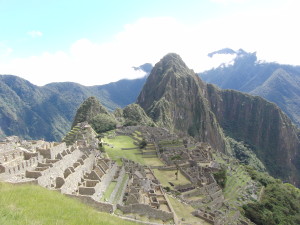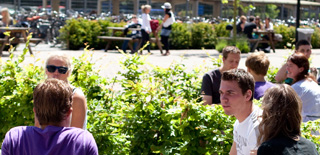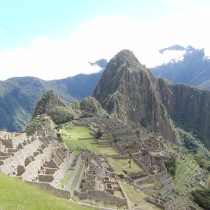Awamaki
Placement organization
Name of organization: Awamaki
Town/city: Ollantaytambo
Country: Peru
Website: http://awamaki.org/
Student
Name of student: Simone Verstegen
Specialist area: TM
Placement period: 2015-2016
Information about placement organization
Type of organization: non profit organisation
Organization’s activities: Awamaki is an organisation which works to economically empower disadvantaged Quechuan women and preserve the traditional craft of weaving in Ollantaytambo, a small town in Peru’s Sacred Valley. Awamaki runs three programs: Women’s Cooperatives, Sustainable tourism and Community Education.
The women’s cooperatives program organizes women’s groups who work in spinning, weaving, knitting and sewing. Through regular skill-building workshops we enable the women to improve the quality of their products. Awamaki then connects the cooperatives with access to local and international markets through our fair trade store and international sales.
Our sustainable tourism program directly benefits community members. We work with local artisans and weavers in our cooperatives that would otherwise not have access to tourism market. By promoting cultural and educational tourism to those passing through Ollantaytambo awamaki tours offers travellers unique insight into Quechua life and provides local families with additional income.
In our community education program, we arrange for international volunteers to teach classes in english and it/computering. We work with staff, volunteers and external trainers to run capacity buildings workshops that cover a variety of topics such as managing houshold finances or working with tourists. Through these classes and workshops, we ai mto give community members the opportunity to build skills and access information that enables the mto increase their incomes and quality of life.
Target group of the organization: Travellers who are interested in the local communities
Company culture: Awamaki is a nonprofit social enterprise that empowers rural Andean women with skills training, connects them to global market opportunities, and enables them to earn an income to transform their communities.
Number of employees: 30
Dress code: casual
Did the organization meet the agreements you made beforehand? yes
Information about your placement
In which department(s) are you working? I’m working in the sustainable tourism program.
We work with local artisans and weavers in our cooperatives that would otherwise not have access to tourism market. By promoting cultural and educational tourism to those passing through Ollantaytambo awamaki tours offers travellers unique insight into Quechua life and provides local families with additional income.
Brief description of your daily activities: Sustainable tourism volunteers take visitors to the nearby indigenous community of patacancha to lead respectful and sustainable Quechua community visitis, and educate travelars about the traditional weaving techniques and awamaki’s fair trade initiatives. This can include half-day visitis as well as cultural immersion workshops with community homestays that last up to 4 days.
Brief description of your company assignment: I started with the marketing for the tourism department, to receive more reservations for tours.
Comment briefly on your supervision by the organization: My colleagues are very helpful. I can always talk to my supervisor.
Requirements for students on placement
What kind of personal skills are required for this placement? Sociable and flexible
Additional company requirements for this placement? Ms office
English: Intermediate
Spanish: Basic
French:
German:
Italian:
Other languages: Quechua
The trip
Mode of transport to reach your destination: Airplane and car
Accommodation
How did you arrange your accommodation? Homestay family
How did you go to work every day? By foot
Visa / work permit / vaccinations
Do you need a visa? yes
Do you need a work permit? no
How did you arrange the necessary documents:
How much time did it take to arrange the necessary documents?
Did you need certain vaccinations? Yes
How long in advance? 4 months in advance
Language course
Did you take a language course before you started your placement? No
Would you recommend to have a language course prior to this placement? yes, Spanish
The costs in euros
Travelling expenses (e.g. return ticket): € €1000,00
Accommodation (monthly): € €120,00
Local transport (monthly): € €15,00
General costs of living (monthly): € €130,00
Costs of visa: € €0,00
Costs of work permit: € €0,00
What did the company pay for/to you? The organization has paid nothing for me
Culture
How did you prepare for the country’s culture?
I’ve bought a book about Peru before I went here, but you will only really experience the culture when you live here.
Did the culture of the country influence your performance during the placement in any way? sometimes
Future students on placement
Future students are free to contact me for further information: Yes
My e-mail address: simone.verstegen@xs4all.nl
Other information
Recommendations on what to do and what not to do: – Do not carry valuables around or wear expensive jewellery. Crime rates in the cities and villages of Peru are high.
– Do not drink the tap water, buy bottled water instead.
– Do not eat food from street to avoid becoming the victims of wretched stomach upset, vomiting, diarrhea and worse.
– Do not take pictures of people without their permission.
– Do learn a few words of Spanish before travelling.
– Do shake hands and kiss men and women once in the cheek for greeting.
– Do bring your own toilet paper, and expect to pay to use a restroom.
– Do expect to pay higher price than locals.
– Do be a responsible traveller, be respectful to locals and local traditions, and protect the nature.
Leisure possibilities in the city/surroundings of where the placement took place: The beautiful rio Urubamba valley popularly known as el valle sagrado ( the sacred valley). The star attractions are the lofty inca citadels of pisac and ollantaytambo, which preside over its undulating twists and turns. But the valley is also packed with other inca sites, as well as hectic markets and fetching Andean villages. It is famous for some high-adrenaline activities, from river running to trekking to rock climbing.
Pisac- is the most convenient starting point for a visit to the sacred valley. There are two distinct parts to pisac: the colonial village lying beside the river and the inca fortress perched dramatically on a mountain spur above.
Ollantaytambo ruines – the huge, steep terraces that guard Ollantaytambo’s spectacular inca ruins mark one of the few places where the Spanish conquistadors lost a major battle.
Salinas – this is one of the most spectacular sights in the whole cuzco area. The thousands of salt pans here have been used for salt extraction since inca times. A hotspring at the top of the valley discharges a small stream of heavily salt-laden water, which is diverted into the mountainside pans and then evaporated to produce a salt used for cattle licks.
Machu Picchu – one of the best-known archaeological sites on the continent, this awe-inspiring ancient city was never revealed to the conquering Spaniards and was virtually forgotten until the early part of the 20th century.
Cusco – this is a beautiful city riddled with contrasts between the indigenous styles and the modern western world. It is these contrasts that have given Cusco its rare beauty.
Media

Youtube link Youtube placement video link


